The point of view is the method used to tell the story to the reader or audience. Fiction often uses a number of ways to employ the point of view of a story is told into height the mood of the story and to elevate the audience's enthusiasm. There are three primary points of view. The first-person point of view is a commonly used way to tell a story. Using this method, a character from the story narrates the story. You can generally sense this by the use of sentences that include the word "I". Less commonly used in extended works the second person point of view is formed around the sentence you. This allows the author to draw the reader into the actual story. Being able to write in a number of different viewpoints is not easy, only master writers are able to perfect the use of all these forms. In some cases, authors will switch the view point in the middle of the work. These worksheets will help you learn how determine the point of view that is being explored in a written work.
Printable Point of View Worksheets
Click the buttons to print each worksheet and answer key.

Clues to Work With
A sentence can contain "clue words" that will help you to figure out the view point (first, second, third) of a story. Study the clue words below. Then sort them into the correct boxes.

Identifying Points of View
Identify the views in each of the passages and then explain your answer. Use the evidence that exists within the text that is provided.
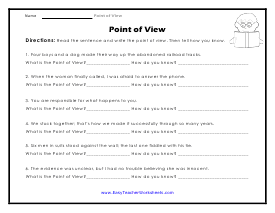
Write What They Are Getting At
See if you can try to understand what view is being thrown at you in this work. Then tell how you know.
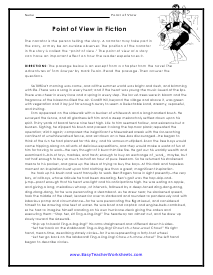
Views in Fiction
The narrator is the person telling the story. A narrator may take part in the story, or may be an outside observer.
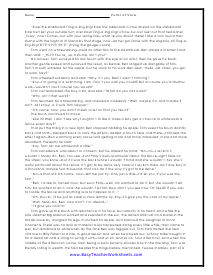
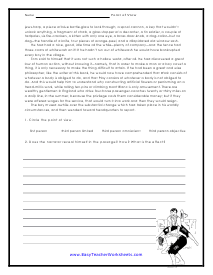

Understanding The Angle
Breakdown all the views that you are seeing here. There will be several thoughts about this.
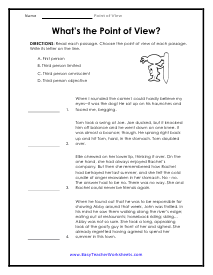
What's Up With That Passage?
Read each passage. Choose the point of view of each passage. Write its letter on the line.
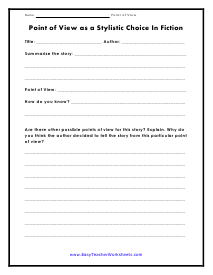
Stylistic Choices In Fiction
Are there other possible views for this story? Explain. Why do you think the author decided to tell the story from this particular point of view?
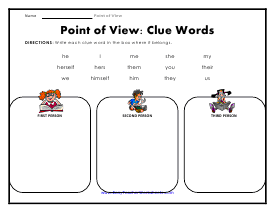
Using Clue Words
Write each clue word in the box where it belongs. See which of these clue words fits into which perspective.
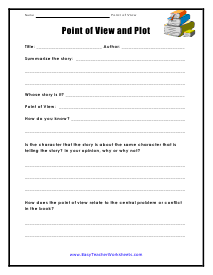
Reasons For The Plot
Is the character that the story is about the same character that is telling the story? In your opinion, why or why not?
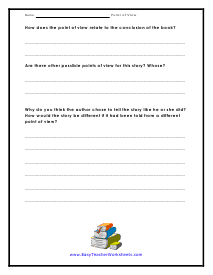
More Questions
Why do you think the author chose to tell the story like he or she did? How would the story be different if it had been told from a different point of view?
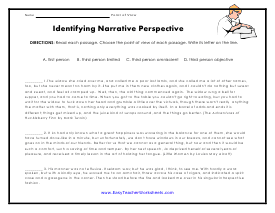
Identifying Narrative Perspective
Read each passage. Choose the author's view of each passage. Write its letter on the line.
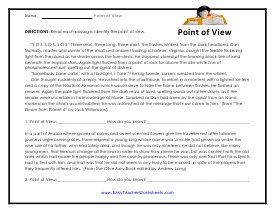
Spill the Beans
: Read each passage. Identify how the message is coming at you from the author and how you know this.
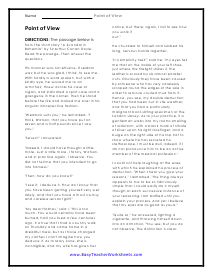
A Scandal in Bohemia
The passage below is from the short story "A Scandal in Bohemia" by Sir Arthur Conan Doyle. Read the passage. Then answer the questions.

Sherlock
The main character of the story is Sherlock Holmes. He is also the one who knows more than anyone else, and the one who ultimately solves this mystery.
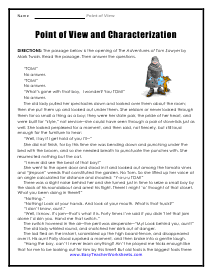
Characterization
The passage below is the opening of The Adventures of Tom Sawyer by Mark Twain. Read the passage.
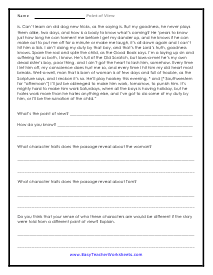
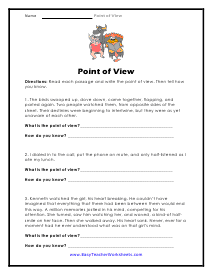
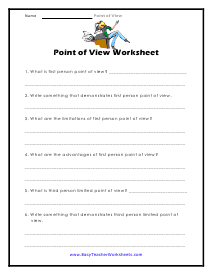
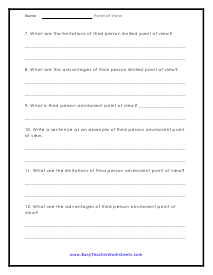
How to Identify the Author's Point of View?
Imagine being able to read another person's thoughts and feelings. Who wouldn't want that? You'd be able to discern their thoughts, feelings, convictions, and motivations for doing things the way they do. However, unfortunately, our ability to read minds is limited. But when it comes to depicting the moods and feelings of an author, readers with a strong presence of mind tend to succeed. It's not uncommon for authors to leave hints in their works of fiction and nonfiction that allow readers to gain insight into the minds and souls of the authors themselves.
One of the biggest obstacles for English students is to learn how to write from different points of view. With the first person being the easiest point of writing view to learn, you want to focus on the worksheets that challenge your kids to look at writing from a second and third person point of view. After learning about the three primary distinct views, teachers should then move into the more difficult third person derivative view points that expand the literary talents of your class. Students are taught to respect different points of view and to debate those view. We now want them to express their own points through writing and discussion.
You can identify the author's point of view by understanding the following components of the text:
1. Tone
The tone is one of the most critical components of a story. Analyzing the tone is a fantastic start to identifying the author's point of view. The passage's mood, ambiance, or feeling determines its tone. Some pieces have a melancholic, dismal tone, while others are stoic and intellectual. Some pieces are upbeat and positive, while others are sartorial. Some of the various types of tones are as follows:
- You can expect a more formal tone if it's academic work.
- You can expect a more personal tone if it's a blog. However, an editorial will be a bit more formal than an opinion piece.
- You can expect a sensational tone if it is a piece of breaking news or a sartorial piece.
- You can expect a humorous tone if it's an entertaining piece.
- You can expect a serious tone if it's a historical piece.
2. Audience
The second component is the audience. You need to know who the audience is to build up the anticipation. When writing for a board of directors, the language and tone will be more formal than when writing for teenagers.
3. Vocabulary
You can now turn your attention to the text itself. The author's choice of words plays a big part in setting the story's mood. So, what are the author's preferred choices of words? Is it a formal, scholarly, or mysterious style of writing? Is it more informal, accessible, and relatable? You need to figure out to identify the author's point of view.
What Questions Should You Ask?
The following are some questions you should ask while reading the story to identify the author's point of view:
- What is the author's voice?
- Is there a specific tone, the author, is going for here?
- What is the reader's emotional response to the text?
- In what ways are the connotative and denotative meanings of a word different?
- Is there a particular point of view that the author wishes to convey?
- What can we infer about the author's intentions from this passage?
- What effect do the words and phrases have on the tone of the passage?
- What is the primary reason for writing the text in the first place?
- Whose perspective does the author have on the issue in this piece?
- Are there any prior experiences you can draw on when reading this text?
- Were you able to think about what you were reading?
- What can you generalize about the protagonist?
- Have you read any other books that share the same theme?
- What's the gist of the story?
- What was the outcome of the story?
- Write a synopsis of the story. Include the beginning, middle, and end.
Final Words
And that's how you can identify the author's point of view. Remember - practice makes a man perfect. You need to read extensively to understand the author and their viewpoint.

